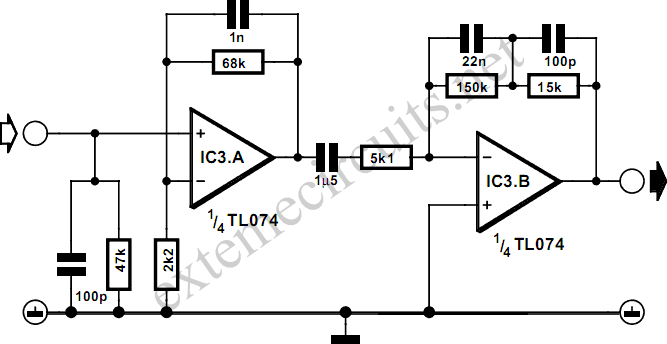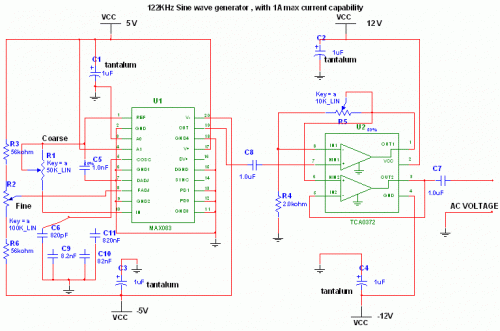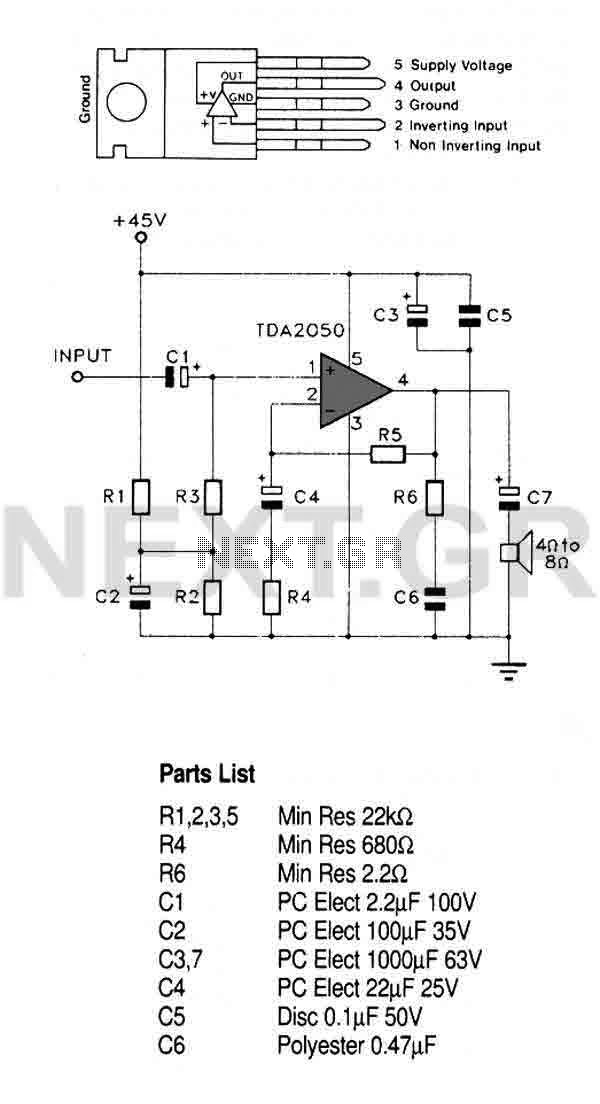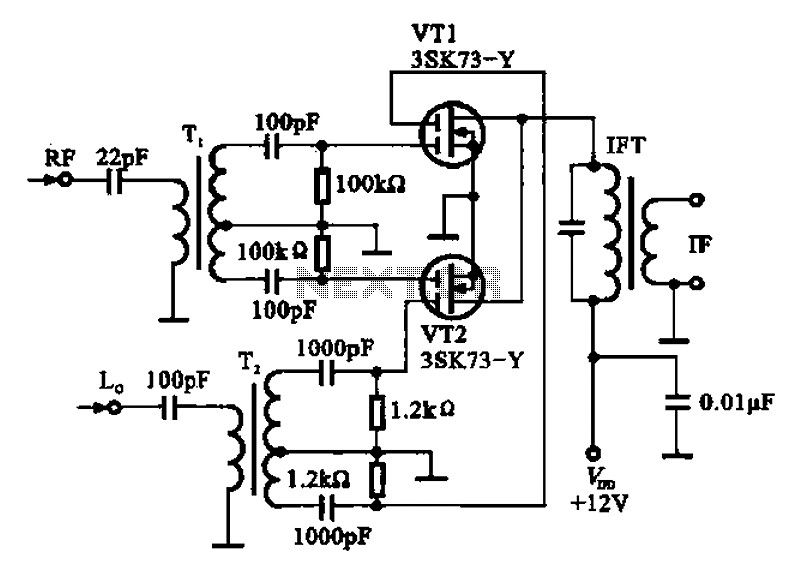
High Impedance DC Voltmeter Circuit Using Op Amp

This design outlines a high impedance DC voltmeter circuit utilizing the uA741 integrated circuit (IC). The uA741 is configured as a non-inverting DC amplifier. The circuit incorporates negative feedback through a DC meter that requires 1 mA for full-scale deflection. The operation of this circuit is based on the fact that with a resistor R6 valued at 100 Ohms, the meter will indicate full-scale reading when the DC input voltage at pin 3 equals the voltage drop across R6, which is 0.1 volts. A selection of resistors R1 and R2 allows for different voltage ranges, as detailed in the accompanying table. Diodes D1 and D2 serve to protect the IC from accidental excessive input voltages, while diodes D3 and D4 safeguard the meter against overload conditions. The circuit can be powered using a dual power supply of +9V and -9V.
The high impedance DC voltmeter circuit is designed for accurate voltage measurements across a wide range of input voltages while minimizing loading effects on the circuit under test. The uA741 op-amp is selected for its favorable characteristics, including low input bias current and high input impedance, which is essential for high impedance applications. The non-inverting configuration allows for a straightforward voltage gain setup, where the gain can be adjusted by selecting appropriate values for resistors R1 and R2, thus enabling the user to switch between different voltage measurement ranges efficiently.
The feedback mechanism through R6 ensures that the meter's full-scale deflection occurs at a specific input voltage, enhancing the precision of the measurement. The specified 0.1 volts drop across R6 allows for a clear and consistent reference point for calibration. The inclusion of protective diodes (D1, D2, D3, and D4) is critical for enhancing the robustness of the circuit. These diodes prevent damage from overvoltage conditions, ensuring that both the IC and the measuring meter remain operational under adverse conditions.
The dual power supply configuration (+9V/-9V) is advantageous as it provides the necessary headroom for the op-amp to function effectively, allowing it to handle both positive and negative input voltages without distortion. This further ensures that the voltmeter can accurately measure AC signals when appropriately configured, making it versatile for various electronic testing applications. Overall, this high impedance DC voltmeter design is efficient, reliable, and suitable for laboratory and field use, capable of delivering precise voltage readings across a wide range of applications.This is a design for a high impedance DC voltmeter. This circuit is design with built by uA741 IC. This IC is a op-amp non-inverting DC amplifier. The IC have negative feedback that is through a DC meter requiring 1mA for full scale deflection. This is the figure of the circuit. The principle work of this circuit is since R6 is 100 Ohms, the meter will show full scale reading when the DC input voltage to pin3 is equal to the voltage drop across R6, viz 0. 1 volts. Choice of R1 and R2 for getting different voltage ranges are shown in the table. The diodes D1 and D2 protect the IC from accidental excessive input voltages and diodes D3 and D4 protect the meter from overloads.
The circuit can be powered from a +9V/-9V dual power supply. 🔗 External reference
The high impedance DC voltmeter circuit is designed for accurate voltage measurements across a wide range of input voltages while minimizing loading effects on the circuit under test. The uA741 op-amp is selected for its favorable characteristics, including low input bias current and high input impedance, which is essential for high impedance applications. The non-inverting configuration allows for a straightforward voltage gain setup, where the gain can be adjusted by selecting appropriate values for resistors R1 and R2, thus enabling the user to switch between different voltage measurement ranges efficiently.
The feedback mechanism through R6 ensures that the meter's full-scale deflection occurs at a specific input voltage, enhancing the precision of the measurement. The specified 0.1 volts drop across R6 allows for a clear and consistent reference point for calibration. The inclusion of protective diodes (D1, D2, D3, and D4) is critical for enhancing the robustness of the circuit. These diodes prevent damage from overvoltage conditions, ensuring that both the IC and the measuring meter remain operational under adverse conditions.
The dual power supply configuration (+9V/-9V) is advantageous as it provides the necessary headroom for the op-amp to function effectively, allowing it to handle both positive and negative input voltages without distortion. This further ensures that the voltmeter can accurately measure AC signals when appropriately configured, making it versatile for various electronic testing applications. Overall, this high impedance DC voltmeter design is efficient, reliable, and suitable for laboratory and field use, capable of delivering precise voltage readings across a wide range of applications.This is a design for a high impedance DC voltmeter. This circuit is design with built by uA741 IC. This IC is a op-amp non-inverting DC amplifier. The IC have negative feedback that is through a DC meter requiring 1mA for full scale deflection. This is the figure of the circuit. The principle work of this circuit is since R6 is 100 Ohms, the meter will show full scale reading when the DC input voltage to pin3 is equal to the voltage drop across R6, viz 0. 1 volts. Choice of R1 and R2 for getting different voltage ranges are shown in the table. The diodes D1 and D2 protect the IC from accidental excessive input voltages and diodes D3 and D4 protect the meter from overloads.
The circuit can be powered from a +9V/-9V dual power supply. 🔗 External reference





